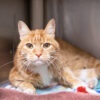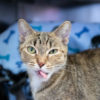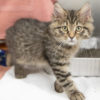We talk a lot about resource guarding in dogs, but not as much time is spent talking about this issue in cats. Why is that? It may be that this issue isn’t identified in cats nearly as often as dogs, though the causes and treatment are very similar. It’s much more common in kittens than in adult cats, as many, many cats grow out of this behavior, if they’re give proper resources and care.
Resource guarding occurs when a cat becomes possessive or protective over a resource that they find highly valuable. That resource could be food, treats, toys, a special bed or their favorite person, among other things. Some of the things that cause this behavior could anxiety or stress within the home due to other animals, the human dynamics in the home, lack of consistency or routine or lack of confidence within the cat. Lack of proper socialization and care can also cause this behavior.
What are some behaviors we could see from a cat who’s resource guarding? They may hiss or growl over their bowl of food, especially when another cat approaches the food. The same could be true of a cat who hisses or growls when another cat comes near and they’re napping on their favorite person’s lap. They may also block access to critical resources like food, water or litterbox.
What do I do if my cat or kitten displays this behavior? Here are a few things you can implement immediately to start reducing your cat’s need to guard resources:
- Make sure your cat has a full medical work up. Pain and illness can cause a variety of behavior concerns!
- Offer multiple feeding stations, litterboxes, toys, beds, vertical spaces… comfort items, special cat safe spaces, food and toys should all be offered in abundance.
- Lots and lots of attention for all of the cats and animals in your home, but especially lots of time and attention offered to the cat who is guarding.
- Building confidence is key and we can do this by offering lots of choice and giving them a lot of our time
- Manage relationships with anyone in the home your cat may not feel safe or comfortable with.
- Make sure your cat has a positive, safe relationship with all of the humans at home
- Manage relationships between animals in your home.
- Make sure that the cat who is having issues is feeling safe, comfortable and relaxed with the other animals in the home
- Offer routine and consistency in feeding times, playtime, bedtime and any other big events during the day
- Consistency builds trust that food, time and play resources are always available, reducing the need to guard
- Change can be a threat to resources for cats!! Ease your cat into change and reassure that everything is ok after a big change has happened in your home.
- Learn the “trade game”. If your cat is upset over a special toy or treat, offer something you know they love so that you can distract them from the object that they’re guarding. You can then safely remove what they’re guarding.
Never punish your cat for this behavior, or force handling and interaction on them while they’re engaging in this behavior, as this will only serve to increase the likelihood of your cat guarding that object.







